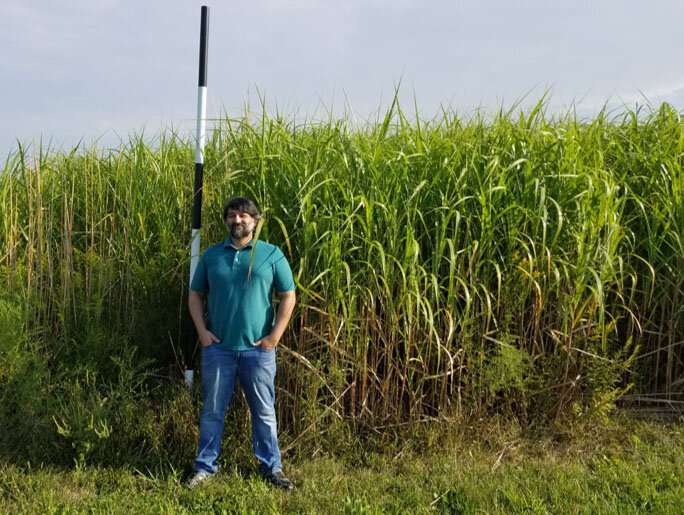This article has been reviewed according to Science X's editorial process and policies. Editors have highlighted the following attributes while ensuring the content's credibility:
fact-checked
trusted source
proofread
Carbon mitigation payments can make bioenergy crops more appealing for farmers

Bioenergy crops such as miscanthus and switchgrass provide several environmental benefits, but low returns and profit risks are barriers for investment by farmers. A new study from the University of Illinois Urbana-Champaign shows that carbon mitigation payments could increase net returns and reduce income risk, potentially enticing more farmers to grow these crops.
The paper is published in the Journal of the Agricultural and Applied Economics Association.
"We were interested in looking at the returns to farmers and the risks to farm income of adopting bioenergy crops compared to conventional corn and soybean crops. We also wanted to look at the effects of paying farmers for the carbon mitigation services from these crops and how that would impact returns and risks," said Madhu Khanna, Alvin H. Baum Family Chair and director of the Institute for Sustainability, Energy, and Environment (iSEE). She is also the ACES Distinguished Professor of Environmental Economics in the Department of Agricultural and Consumer Economics (ACE) and co-director of the Center for the Economics of Sustainability (CEOS), part of the College of Agricultural, Consumer and Environmental Sciences (ACES) at the U. of I.
"There are two main carbon mitigation benefits from bioenergy crops: First, bioenergy crops have deep roots that sequester more soil carbon than conventional crops. And second, the harvested biomass can be used to produce cellulosic biofuel to replace fossil fuels," explained Fahd Majeed, a postdoctoral research associate at iSEE and the U.S. Department of Energy's Center for Advanced Bioenergy and BioProducts Innovation (CABBI) at the U. of I. Majeed conducted the research as a doctoral student in CEOS.
Potential biomass profitability and return riskiness, along with the subsequent carbon mitigation potential of these crops, varies spatially due to weather-related yield risk and relative returns from conventional crops. Policies aimed at incentivizing farmers to convert cropland to bioenergy crops will need to address return riskiness along with high upfront costs and long establishment periods.
"Some farmers may be risk-averse and prefer lower but more stable profits, while others may be risk-neutral and prefer higher profits regardless of risk; however, this information may not be known to a policymaker," Majeed noted. "Our analysis allows us to compare and rank risky returns from bioenergy crops and conventional crops when farmer risk preferences are unknown."
The study employed a biogeochemical model to simulate yields of bioenergy crops (miscanthus and switchgrass) and conventional crops (corn and soybean) under 30 years of randomized weather conditions. The researchers performed the analysis for 2,122 counties in the rainfed region of the United States, on or east of the 100th meridian. For conventional crops, they included corn-corn or corn-soybean rotation and till versus no-till practices.
They combined the yield analysis with an economic model estimating crop prices and carbon mitigation payments to gauge the appeal to different types of farmers across locations.
As both bioenergy and conventional crops vary in returns and riskiness across biomass and carbon prices, the researchers examined bioenergy crop profitability at biomass prices of $40 and $60 per metric ton and carbon payments of $0, $40, and $80 per metric ton of carbon dioxide (CO2). They found that bioenergy crops would not be profitable without carbon payments at lower prices. With carbon mitigation payments, these crops would appeal to risk-averse farmers; that is, farmers who are willing to accept slightly lower but less variable returns relative to conventional crops. At the higher biomass price of $60 per metric ton, carbon mitigation payments increase returns and reduce riskiness such that growing bioenergy crops would appeal to farmers regardless of risk preference.
Further, comparing the two bioenergy crops, the researchers found that miscanthus would be preferred over switchgrass by farmers in the Midwest, while switchgrass would be preferred over miscanthus by farmers in the southern states. This is due to spatial differences in the expected yield, carbon mitigation potential, and costs across bioenergy crops, the researchers said.
Overall, carbon mitigation payments can make bioenergy crops more appealing to farmers, but payments should be adapted to the varying potential yield, carbon mitigation, and riskiness of returns across regions.
"One policy implication from this study is that if you want to reduce risk, carbon credits are a good policy. But the incentives need to be tailored spatially; a uniform payment per acre of land across the whole region is not going to be the most effective. Carbon credits that vary across the region based on carbon mitigated will create differentiated incentives across the region compared to a uniform policy. The former will also be cost-effective in achieving an aggregate target for carbon mitigation," Khanna said.
Currently, carbon mitigation payments are primarily facilitated through voluntary markets where companies and other organizations can purchase credits to meet their carbon reduction goals. Such markets can be supplemented with government programs to incentivize bioenergy crop production, the researchers noted.
More information: Fahd Majeed et al, Carbon mitigation payments can reduce the riskiness of bioenergy crop production, Journal of the Agricultural and Applied Economics Association (2023). DOI: 10.1002/jaa2.52
Provided by University of Illinois at Urbana-Champaign

















